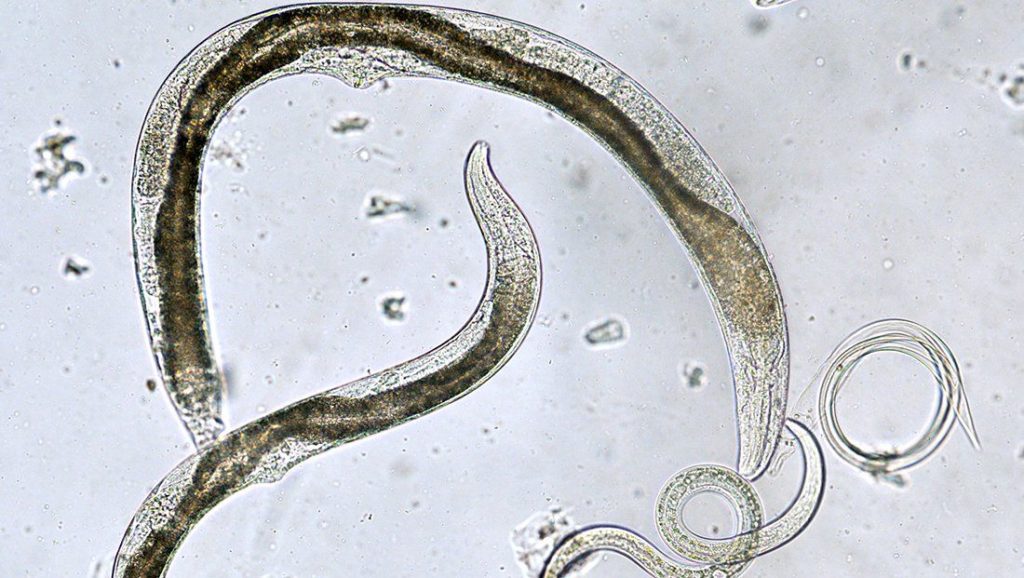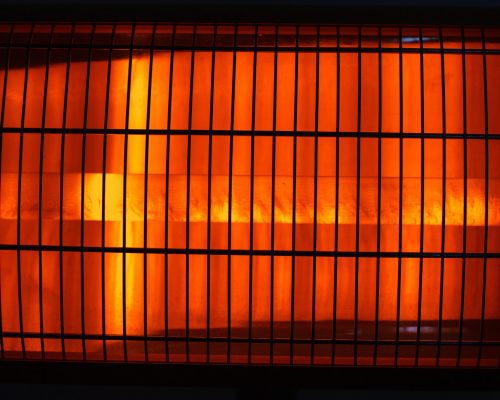1. Beneficial Nematodes

Beneficial Nematodes are parasites used as a biocontrol for pests.
They attack insects but don’t pose any harm to plants, pets, and humans.
Beneficial Nematodes are deadly to termites—specifically, subterranean termites.
They enter the termites through their spiracles.
Once inside, they release a deadly bacteria that kills the termites within 48 hours.
When tested in a lab, nematodes were able to eliminate 82% of termites after two weeks.
Nematodes are especially effective on soft soil as it makes it easy for nematodes to travel through and attack the termites.
To apply Beneficial Nematodes, combine the entire pack with one gallon of water.
Let it sit for 10-15 minutes before pouring into a spray bottle.
Spray the mixture on infested wood. You can also spray it directly on mud tubes.
Spray nematodes daily for at least two weeks.
2. Wood Vinegar
Wood vinegar is a natural product made of wood and other plant materials.
Wood vinegar is an excellent pesticide.
In a study, wood vinegar was able to eliminate termites in seven days with a 2% concentration.
And at an 8% concentration, wood vinegar can reach a 100% mortality rate in only 3 days.
To treat termites with an 8% solution, mix 8ml of wood vinegar with 100ml water.
Transfer to a spray bottle and apply it to infected areas.
For the best results, continue applying the solution daily for at least seven days.
3. Borates / Boric Acid
Boric acid or Borax is another excellent way to eliminate termites.
A study found boric acid can eliminate termites on wood between 70% and 89% after ten days.
Keep in mind that for boric acid to be effective, it needs to seep into the wood evenly.
To make sure the wood absorbs the acid well, apply several layers to all sides of the wood.
Borate is also effective in a powder form.
In this study, powdered boric acid was shown to have a 100% mortality rate on termites after 15 days.
Powder boric acid is highly effective because it instills horizontal transfers.
Once the dust covers the termites, they return to the colony and infect the rest of the population.
When using boric acid powder, I recommend you use a dusting bulb.
A dust bulb will allow you to get into small and deep holes.
Using 3-4 pumps should be enough to fill an entire gallery of termites.
To treat termites with boric acid, dissolve 10 oz. of Borax with warm water.
Mix and transfer the mixture to a spray bottle.
Then, spray the infested areas with the solution.
Repeat the application for seven days to allow the boric acid to penetrate the wood thoroughly.
Another common borate product used to kill termites is Bora-Care.
Using a pressure sprayer you can apply Bora-Care on untreated wood.
The borate solution will soak into the wood, and any termite that eats the wood will die.
Once absorbed, Boracare will stay on the wood for its lifetime as long as it is sealed and coated.
To apply Bora-care to painted or sealed wood, you will need to drill into the wood and inject it.
For the best results, drill holes every 6 to 8 inches and inject for 2-5 seconds in each hole.
4. Essential Oils

Essential oils can both repel and kill termites hiding in the wood around your house.
A study found that essential oils can deliver between 70% and 100% mortality rate after three days.
Some of the most effective essential oils for termites are:
- Orange Oil
- Garlic Oil
- Clove Oil
You can spray these oils directly at the termites and areas where termite infestations are present.
For this, I recommend using a pressurized insecticide sprayer with a fine point nozzle.
This sprayer will allow you to get into small entry points on the wood.
If you can’t find entry points, I recommend drilling a small hole into the infested area.
Here’s how:
- Drill the wood until you feel the hollow portion.
- Create holes for every 8-12 inches on wood.
- Insert the nozzle into the drilled holes.
- Spray the essential oil solution into the wood holding for 2-5 seconds.
The solution will seep through the wood and kill any termites located inside.
You can also spray the outside wood to repel termites.
I recommend only applying a coating to the outside of your home rather than the inside.
Once you have removed any termites inside your home, the essential will repel any termites from trying to get in.
5. Diatomaceous Earth
Diatomaceous earth kills termites by destroying their exoskeletons.
When DE gets on a termite, it absorbs the oily outer cuticle found on its exoskeleton.
Once the outer layer is destroyed, the termite loses water and die from dehydration.
Apply DE to the entry or exit point on infected pieces of wood.
To access small holes, I recommend using a duster bulb.
To apply it to mud tubes, I recommend breaking the tube and placing the DE inside.
Once the termites fix the mud tube, they will come into contact with the DE and die.
Remember, for DE to be effective, it must be dry.
If your attic, basement, or bathroom is humid, use fans to minimize moisture before applying DE.
Reapply DE outdoors if it rains or becomes too humid.
Also, remember to use a protective mask and safety goggles while applying DE.
Just like any dust, inhaling DE dust can irritate your lungs.
But the silica found in DE makes it especially harmful.
The silica on DE can also irritate the skin and eyes.
6. Heat Treatment

Temperatures above 120 Fahrenheit are fatal to termites.
As such, applying heat is one of the best ways to eliminate termites naturally.
Heat treatment generally lasts between 4- 8 hours.
That’s because the temperatures inside the wood must reach 120 degrees Fahrenheit for at least 35 minutes to kill the termites.
Smaller homes require less time, while larger homes require more time.
The only downside of this treatment is that it requires hiring professionals and is typically expensive.
7. Cold Treatment
Another way you can eliminate termites is by freezing them.
Temperature below 25 degrees is fatal to termites.
Most professionals do this by injecting liquid nitrogen into infested areas.
Liquid nitrogen can reach temperatures of -320 degrees, which can quickly kill termites.
Like heat treatments, the downside of this method is that it tends to be expensive.
While this approach is free of toxic chemicals, liquid nitrogen can be dangerous if not handled with care.
As such, you’ll likely need professional help, which can be costly.
8. Beauveria Bassiana
Beauveria Bassiana is a fungus that grows naturally in soils.
It’s used around the world for insect control applications.
This fungus infects different invertebrates they come into contact with.
Once they get on their cuticle, they spread into their blood and feed on it.
This process kills the insect within three to five days.
As for termites, the fungus was able to reach a 100% mortality rate after ten days.
Applying Bauveria Bassiana typically involves mixing the solution with water.
Then, using a spray bottle, apply the solution to all infested areas.
Once applied, Bauveria Bassiana will take effect at around day 7.
BB fungus is regarded as safe for humans and pets.
In fact, it is commonly used to treat bed bugs due to its highly effective nature at eliminating entire infestations.
It is often used as a pest control method by agricultural farmers to avoid using pesticides on their crop.
9. Termite Barrier
Another option to kill or eliminate termites from your home is to use termite barriers.
These are physical barriers that prevent termites from entering your home.
Physical, non-chemical barriers include sand and basaltic particle barriers, as well as stainless steel mesh barriers.
These barriers are effective at controlling subterranean termites because they won’t be able to enter through the foundation of your home.
After applying a physical barrier around your home, any subterranean termites that are unable to maintain contact with the soil or other moisture sources will die.
If you are building new sections to your home or want to protect your current home, add a physical barrier that termites won’t be able to chew or squeeze through to get inside.
In addition, severing any potential connections to the soil will help kill some of the current termites currently infesting your home.
10. Petroleum jelly
Petroleum jelly is a common household item that you can use to both repel and kill termite.
Termites are not able to digest the chemical phenol found in petroleum jelly.
When consumed, petroleum jelly acts as a slow poison, eventually killing them after 4-6 weeks.
Petroleum jelly is also an excellent termite repellant.
In this study, they showed that a wood treated with phenol prevent 95% of termites from tunneling and eat the wood.
For those termites that entered the wood treated with petroleum jelly, only 18% died after one week.
But after six weeks, the mortality rate has increased to 100%.
To use petroleum jelly as a repellent, spread it across your doors, baseboards, beams, and wooden furniture.
Leave it for a couple of days to dry then use a cloth to polish it.
If you already have a termite infestation, you can add PE into their tunnels or on infested wood to encourage them to digest it.
Just keep in mind, the termites will continue working for the next six weeks until there are any results.
Myths
11. Soap Water
Soap water is another natural way you can kill termites.
The soap will coat the termites’ body and make it impossible for them to breathe.
That said, soap water is not an effective method at eliminating infestations.
Once you spray the water on the wood, it will absorb it, making it too weak to kill the termites inside.
12. Vinegar
Vinegar is a common household item people recommend you use to kill a variety of insects.
Unfortunately, vinegar will not kill termites.
Scientific studies show that the mortality rate of vinegar and the natural mortality rate of termites is not significant.
The study does show that vinegar can cause have small repellancy effect but it only last for 2 days.
However, it is a great way to clean and disinfect surfaces that have been infested by pests.
There is a chance that vinegar is confused with wood vinegar, an effective compound for killing termites.
13. Sunlight
Sunlight can act as natural heat treatment.
The heat from the sunlight removes moisture, which Dampwood and subterranean termites are required to survive.
The problem with this method is that it’s not practical.
It would be tough to expose an entire termite colony to the sun.
14. Drowning
Another option often recommended online is to drown or flood out any subterranean termites.
Termites can survive underwater for 16 to 30 hours.
That means, to drown termites, you would need to keep a constant flow of water.
So while this may work in theory, it’s unrealistic in practice.
Plus, flooding the area around your home will likely draw more termites into your home.
The added moisture will make it a perfect environment for subterranean and damp wood termites to survive.
15. Cardboard Traps
Another natural termite control solution is cardboard traps.
The idea is to use damp corrugated cardboard to draw termites out in the open.
This trap is best used if you suspect a termite infestation outdoors or near outdoor wood.
It is much easier to draw out subterranean and dampwood termites with this trap than drywoood termites.
Once the termites begin to feed on the cardboard, you can terminate by burning the cardboard.
Unfortunately, this method is not very effective at eliminating an infestation.
It’s doubtful that you’ll be able to draw all the termites in your home into one cardboard.
And you cannot burn cardboards faster than termites can repopulate.
